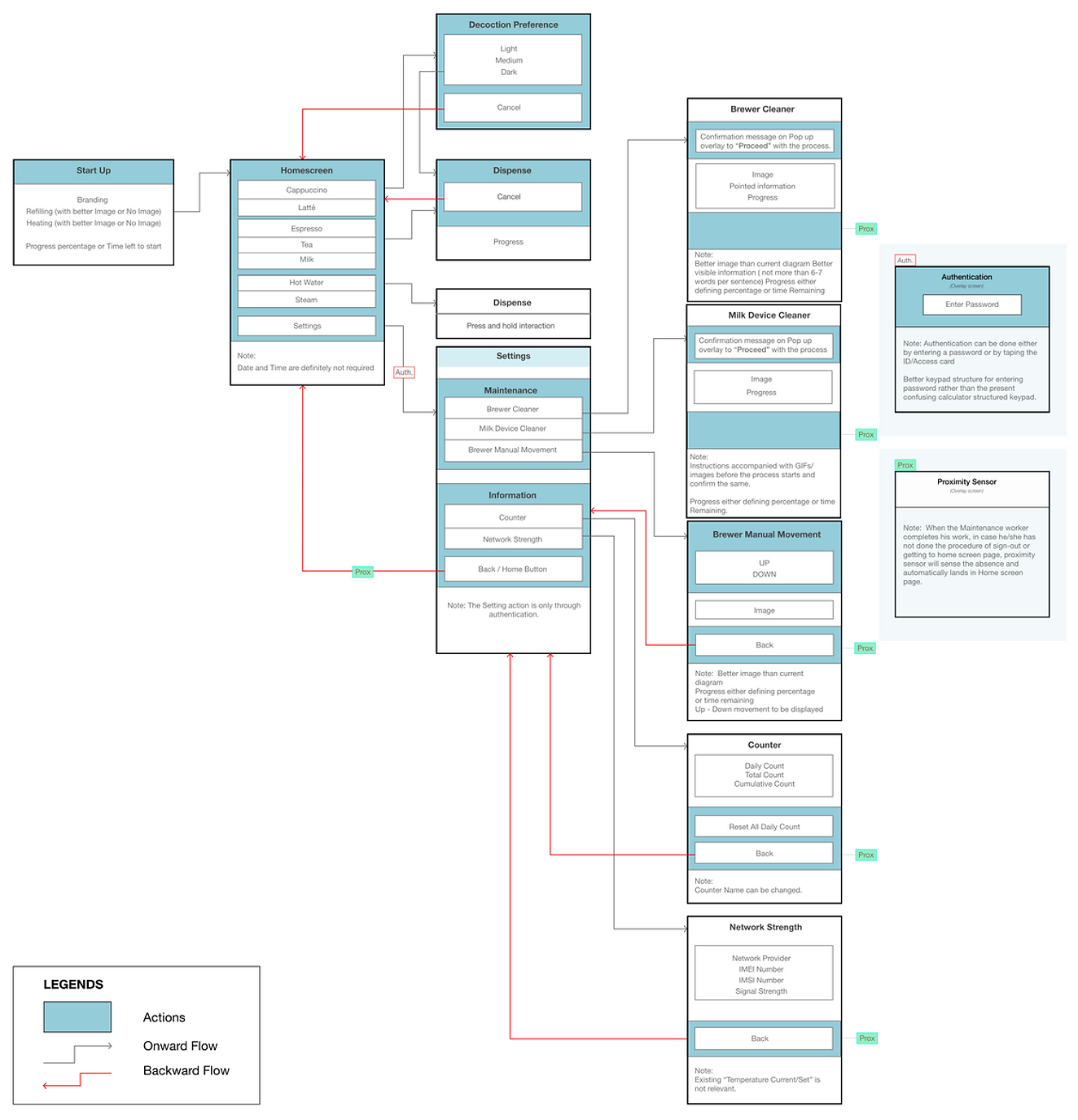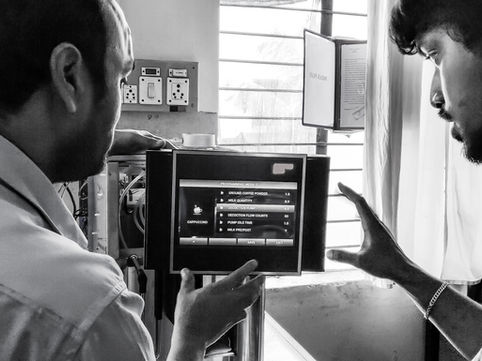
COFFEE DAY TABLET
Coffee Machine Interface
Role - Design Lead
ABOUT
Grab with a Touch!
Coffee Day Global Ltd. also known as CDGL is one of India's leading coffee chain company. They cover different touch points of Indian coffee. Their coffee vending machines are wide spread, ranging from big corporates to small retails. CDGL wanted a user interface for the coffee vending machine that provides a next-generation experience for its end users.
RESEARCH
Know the user
Three main user groups who interacted with the machine were identified . Firstly the end users who directly dispense the beverages from the machine for their consumption, secondly the production engineers who configure the machine from the factory as per the client needs and lastly the service technicians who carry out the regular maintenance of the machine at field. The interactions of these user groups with the machine was studied by contextual enquiries as well as shadowing. The interviews included key stake holders and decision-makers to understand their vision for this project in detail. The current user interface was also evaluated heuristically to understand its pros, cons and future potential. Benchmarking and competitive study was also done to understand the market trends in this field.

ANALYSIS
Key Takeaways
After knowing the three user groups who interacted with the current HMI, the following are the key findings:
Coffee consumers
- Unable to get appropriate information from the coffee machine leading to a disconnected and dissatisfying experience.
- Extra effort to understand the working of the machine. Consents and feedbacks are not available.
- Machine's inability to respond swiftly makes it difficult for quick grabbers to get their beverages.
- Irrelevant information uses up potential screen space.
- Information is not provided visually in a way that is indicative of its difference in functionality.
- Poor information hierarchy
- Repetitive visuals in the HMI making it a monotonous experience.
Production Engineers
- Fragmented workflow leads to wastage of time.
- Vital information are unavailable and inconsistent.
- Ambiguous set-up parameters demand trained engineers and yet consumes time.
Service Technicians
- The machine does not show relevant information when needed to the technician.
- Interactions and visuals are not optimised for service engineers.
- Currently, there is no way to measure the quality of the maintenance.
- Many tasks are to be done manually, making it strenuous to maintain and difficult to track.
- There is no process/system in place for unusual hardware issues.
PROBLEM BRIEF
Our focus in this project
To create a new identity for the CDGL coffee vending machine by re-designing the machine interface (User interface) to enhance the appearance, usability and induce next generation experience for Indian market considering the end user's, production engineer's and service technician's requirements in corporate as well as retail environment.
IDEAS
Digging Deep !
We did an extensive evaluation of the current interface of the vending machine. We tried to find out the major issues in the current UI.
Major issues found in the current system were:
- Absence of information hierarchy and actions to the existing interface.
- Placement of the action buttons are not at a very comfortable position
- Readability issues
- Lack of information and customisation options of the beverages.
- Interface was not designed considering all their user groups (consumer, production engineer and service technician)
- Slow and lagging interface resulted in user clicking multiple times, creating confusion and dispensing of wrong beverages at times.

Current user interface of vending machine

Information Architecture - Current Interface
LANDING SCREEN
Make selection
Steam
Hot Water
PREFERENCE SCREEN
Decoction selection
Progress on dispensing
Stop action
DESPENSING SCREEN
COFFEE READY!!
Prioritisation
Easy selection
Aesthetics
Customisation
Instant
Engaging
Informative
Engages user
Screen flow


Information Architecture - New Interface
INITIAL IDEAS
Concepts
Multiple concepts were ideated and were presented to the client. Keeping the client well connected with the progress in work, helped us in aligning smoothly throughout the project. Their feedbacks helped us to bring more clarity to the client requirement.

BASIC FLOW
Wireframes
The wireframes were detailed with a focus on how to improve continuous engagement with the user. Multiple wireframes were framed and iterated to make a satisfactory interaction.
THE INTERFACE
The final design
The final design was selected based on the client's decision. Multiple iterations were made, considering the technical feasibility of the design. Working closely with the software development team helped us to achieve the desired quality in minimum time.


Hover to view the interaction

Different interaction for add-ons like steam and hot water. Indicative interactions to make sure the user is not confused.

Decoction preferences for the user to customise their drink every time
THEMES
Color and festive themes
An additional requirement from marketing team of the client was to have color themes and festival themes were also integrated into the design.


VARIANTS
Grid Layouts
Cafe Coffee Day have different kind of marketing strategies. Single click interactions with simple grid layout of the basic 5 beverages was our offering for the customers who did not need any sort of customisation. This can be extended to up to 10 beverages as well.

NFC
Restricted usage
Cafe Coffee Day also have customers where the end-users are entitled to dispense only limited number of beverages. And this was monitored by the employee ID card. An NFC based authorisation was designed to cover this use case.


Hover to view the interaction
USER VALIDATION
Let's listen to what users felt!
One of the most effective way of conducting user validation is, when the users are in their context unaware that they are actually being a part of testing. The user validation was conducted in the canteen and pantry areas of corporate offices.
We created a simple mount with acrylic to mount an i-pad in front of the actual coffee machine and the designed interface was running on the iPad. The user interacted with the new interface without any hiccups and was waiting for the beverage to be dispensed. Of course, the interface was not connected to the coffee machine. Once the users completed their task we interrupted the user by asking about their experience with the new interface.














